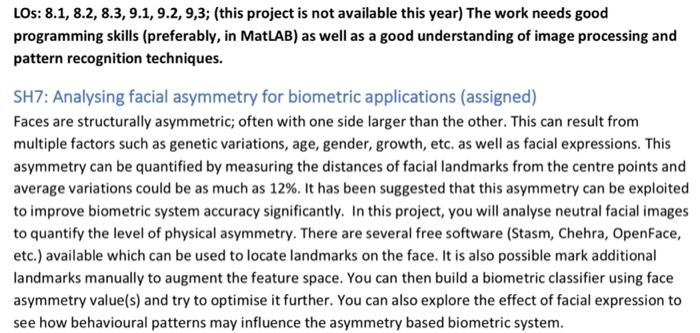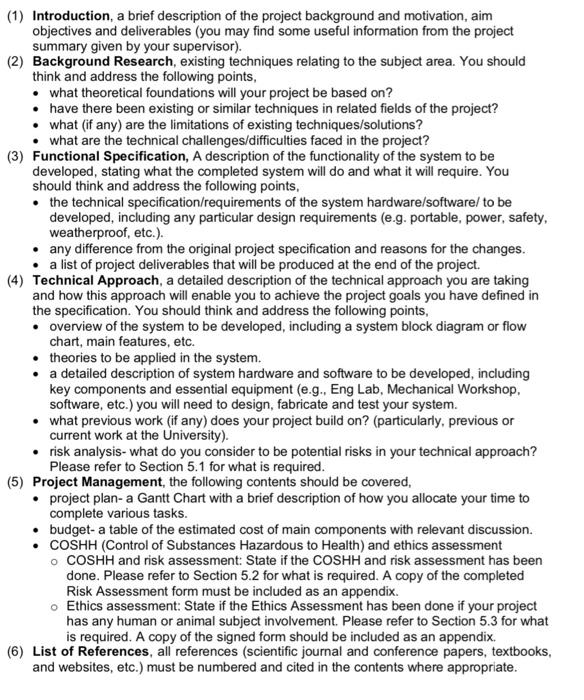LOS: 8.1, 8.2, 8.3, 9.1, 9.2, 9,3; (this project is not available this year) The work needs good programming skills (preferably, in MatLAB) as well as a good understanding of image processing and pattern recognition techniques. SH7: Analysing facial asymmetry for biometric applications (assigned) Faces are structurally asymmetric; often with one side larger than the other. This can result from multiple factors such as genetic variations, age, gender, growth, etc. as well as facial expressions. This asymmetry can be quantified by measuring the distances of facial landmarks from the centre points and average variations could be as much as 12%. It has been suggested that this asymmetry can be exploited to improve biometric system accuracy significantly. In this project, you will analyse neutral facial images to quantify the level of physical asymmetry. There are several free software (Stasm, Chehra, OpenFace, etc.) available which can be used to locate landmarks on the face. It is also possible mark additional landmarks manually to augment the feature space. You can then build a biometric classifier using face asymmetry value(s) and try to optimise it further. You can also explore the effect of facial expression to see how behavioural patterns may influence the asymmetry based biometric system. (1) Introduction, a brief description of the project background and motivation, aim objectives and deliverables (you may find some useful information from the project summary given by your supervisor). (2) Background Research, existing techniques relating to the subject area. You should think and address the following points, what theoretical foundations will your project be based on? have there been existing or similar techniques in related fields of the project? what (if any) are the limitations of existing techniques/solutions? what are the technical challenges/difficulties faced in the project? (3) Functional Specification, A description of the functionality of the system to be developed, stating what the completed system will do and what it will require. You should think and address the following points, the technical specification/requirements of the system hardware/software/ to be developed, including any particular design requirements (e.g. portable, power, safety, weatherproof, etc.). any difference from the original project specification and reasons for the changes. a list of project deliverables that will be produced at the end of the project. (4) Technical Approach, a detailed description of the technical approach you are taking and how this approach will enable you to achieve the project goals you have defined in the specification. You should think and address the following points, overview of the system to be developed, including a system block diagram or flow chart, main features, etc. theories to be applied in the system. a detailed description of system hardware and software to be developed, including key components and essential equipment (e.g., Eng Lab, Mechanical Workshop. software, etc.) you will need to design, fabricate and test your system. what previous work (if any) does your project build on? (particularly, previous or current work at the University). risk analysis what do you consider to be potential risks in your technical approach? Please refer to Section 5.1 for what is required. (5) Project Management, the following contents should be covered, project plan-a Gantt Chart with a brief description of how you allocate your time to complete various tasks. budget- a table of the estimated cost of main components with relevant discussion. COSHH (Control of Substances Hazardous to Health) and ethics assessment o COSHH and risk assessment: State if the COSHH and risk assessment has been done. Please refer to Section 5.2 for what is required. A copy of the completed Risk Assessment form must be included as an appendix. Ethics assessment: State if the Ethics Assessment has been done if your project has any human or animal subject involvement. Please refer to Section 5.3 for what is required. A copy of the signed form should be included as an appendix. (6) List of References, all references (scientific journal and conference papers, textbooks, and websites, etc.) must be numbered and cited in the contents where appropriate. LOS: 8.1, 8.2, 8.3, 9.1, 9.2, 9,3; (this project is not available this year) The work needs good programming skills (preferably, in MatLAB) as well as a good understanding of image processing and pattern recognition techniques. SH7: Analysing facial asymmetry for biometric applications (assigned) Faces are structurally asymmetric; often with one side larger than the other. This can result from multiple factors such as genetic variations, age, gender, growth, etc. as well as facial expressions. This asymmetry can be quantified by measuring the distances of facial landmarks from the centre points and average variations could be as much as 12%. It has been suggested that this asymmetry can be exploited to improve biometric system accuracy significantly. In this project, you will analyse neutral facial images to quantify the level of physical asymmetry. There are several free software (Stasm, Chehra, OpenFace, etc.) available which can be used to locate landmarks on the face. It is also possible mark additional landmarks manually to augment the feature space. You can then build a biometric classifier using face asymmetry value(s) and try to optimise it further. You can also explore the effect of facial expression to see how behavioural patterns may influence the asymmetry based biometric system. (1) Introduction, a brief description of the project background and motivation, aim objectives and deliverables (you may find some useful information from the project summary given by your supervisor). (2) Background Research, existing techniques relating to the subject area. You should think and address the following points, what theoretical foundations will your project be based on? have there been existing or similar techniques in related fields of the project? what (if any) are the limitations of existing techniques/solutions? what are the technical challenges/difficulties faced in the project? (3) Functional Specification, A description of the functionality of the system to be developed, stating what the completed system will do and what it will require. You should think and address the following points, the technical specification/requirements of the system hardware/software/ to be developed, including any particular design requirements (e.g. portable, power, safety, weatherproof, etc.). any difference from the original project specification and reasons for the changes. a list of project deliverables that will be produced at the end of the project. (4) Technical Approach, a detailed description of the technical approach you are taking and how this approach will enable you to achieve the project goals you have defined in the specification. You should think and address the following points, overview of the system to be developed, including a system block diagram or flow chart, main features, etc. theories to be applied in the system. a detailed description of system hardware and software to be developed, including key components and essential equipment (e.g., Eng Lab, Mechanical Workshop. software, etc.) you will need to design, fabricate and test your system. what previous work (if any) does your project build on? (particularly, previous or current work at the University). risk analysis what do you consider to be potential risks in your technical approach? Please refer to Section 5.1 for what is required. (5) Project Management, the following contents should be covered, project plan-a Gantt Chart with a brief description of how you allocate your time to complete various tasks. budget- a table of the estimated cost of main components with relevant discussion. COSHH (Control of Substances Hazardous to Health) and ethics assessment o COSHH and risk assessment: State if the COSHH and risk assessment has been done. Please refer to Section 5.2 for what is required. A copy of the completed Risk Assessment form must be included as an appendix. Ethics assessment: State if the Ethics Assessment has been done if your project has any human or animal subject involvement. Please refer to Section 5.3 for what is required. A copy of the signed form should be included as an appendix. (6) List of References, all references (scientific journal and conference papers, textbooks, and websites, etc.) must be numbered and cited in the contents where appropriate








